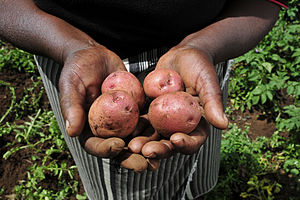
Agriculture in Kenya dominates Kenya's economy. 15–17 percent of Kenya's total land area has sufficient fertility and rainfall to be farmed, and 7–8 percent can be classified as first-class land.[1][2] In 2006, almost 75 percent of working Kenyans made their living by farming, compared with 80 percent in 1980.[1] About one-half of Kenya's total agricultural output is non-marketed subsistence production.[1]
Agriculture is also the largest contributor to Kenya’s gross domestic product (GDP).[1] In 2005, agriculture, including forestry and fishing, accounted for about 24 percent of the GDP, as well as 18 percent of wage employment and 50 percent of revenue from exports.[1]
Farming is the most important economic sector in Kenya, although less than 8 percent of the land is used for crop and feed production, and less than 20 percent is suitable for cultivation. Kenya is a leading producer of tea and coffee, as well as the third-leading exporter of fresh produce, such as cabbages, onions and mangoes. Small farms grow most of the corn and also produce potatoes, bananas, beans, peas and chillies.
- ^ a b c d e Kenya country profile. Library of Congress Federal Research Division (June 2007). This article incorporates text from this source, which is in the public domain.
- ^ Mwanda, C.O. Engineering Division, Ministry of Agriculture. (2000). A note on weed control in Machakos District, Kenya. Retrieved 5 May 2008, from http://atnesa.org.